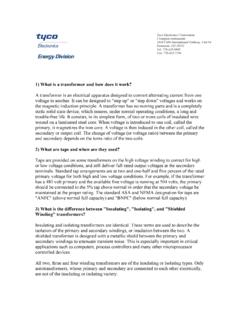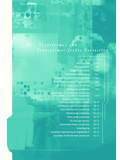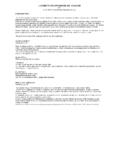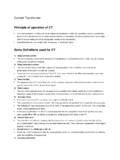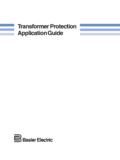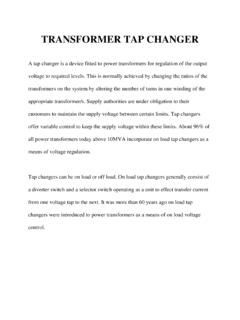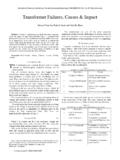Transcription of Transformer Loading & Thermal Design Considerations
1 Transformer Loading & Thermal Design Considerations 46TH Annual UTA TSDOS SEPTEMBER 2013 SPX Transformer SOLUTIONS, INC. transformers | SERVICE | TRAINING | COMPONENTS Transformer Loading & Thermal Design Considerations 2 John joined SPX Transformer Solutions in June 1999, where his engineering and technical support responsibility spans the Service and Components Division. Prior to SPX, he was employed by Duke Energy, where he was responsible for all aspects of Transformer maintenance, development of new maintenance methods and standards as well as analysis and reporting. YOUR PRESENTER: John Pruente Director of Engineering Technical Support SPX Transformer Solutions, Inc. Office: 214-637-4434 Cell: 817-300-6843 SPX Transformer SOLUTIONS, INC. SPX Transformer Solutions, Inc. transformers | SERVICE | TRAINING | COMPONENTS Transformer Loading & Thermal Design Considerations UTA TSDOS September 2013 Thermal Design Considerations Industry Practice on Transformer Loading Theoretical Life Functional Life Monitoring Conclusions Questions & Discussion Agenda 3 SPX Transformer Solutions, Inc.
2 transformers | SERVICE | TRAINING | COMPONENTS Transformer Loading & Thermal Design Considerations UTA TSDOS September 2013 Transformer Losses No Load Losses By-product of energizing (exciting) the core Function of the grade of core steel used, Design induction level and operating voltage Remains constant for varying load Load Losses I R - Varies with Loading and is proportional to the square of the current flowing through the winding conductor Function of conductor material and cross sectional dimension Stray (windings) Result of circulating currents (eddy) within the conductor due to leakage flux Stray (other) Result of circulating currents in tank, core clamps and other magnetic steel components Transformer losses generate heat 4 Thermal Design Considerations SPX Transformer Solutions, Inc. transformers | SERVICE | TRAINING | COMPONENTS Transformer Loading & Thermal Design Considerations UTA TSDOS September 2013 Liquid Temperature Rise Liquid temperature rise above ambient measured in a heat run test shall be determined as equal to top liquid temperature minus half the difference in temperature at the top and bottom of the cooling radiators or coolers (typically 65 C maximum) Average Winding Temperature Rise Average winding temperature of a winding phase shall be determined from the windings hot resistance at shutdown of a heat run test and is related to winding current density and the amount of conductor surface exposed to the surrounding oil in the windings (typically 65 C maximum) Winding Hottest-Spot The highest temperature of a Transformer winding is effected by stray flux and is greater than the average winding temperature (typically 80 C maximum)
3 Thermal Design Considerations (cont.) Source: ANSI 5 SPX Transformer Solutions, Inc. transformers | SERVICE | TRAINING | COMPONENTS Transformer Loading & Thermal Design Considerations UTA TSDOS September 2013 Thermal Design Considerations (cont.) 28 kV, kV 28 kV, kV 28 kV, kV 28 kV, kV 6 Hot-Spot Temperature ( C Rise over ambient) @ kV @ kV @ kV @ kV Hottest Winding 1 Winding 2 Winding 3 Winding 4 Windings 1 and 3 had to be redesigned to lower the hot-spot temperature rise below 80 C. 1 2 3 4 1 2 3 4 1 2 3 4 1 2 3 4 Example Hot-Spot Temperature Calculation SPX Transformer Solutions, Inc. transformers | SERVICE | TRAINING | COMPONENTS Transformer Loading & Thermal Design Considerations UTA TSDOS September 2013 Thermal Design Considerations (cont.) 7 Thermal TESTS Temperature Rises are in C and corrected to instant of shut down.
4 Transformer connected and loaded as follows: All winding currents are listed at maximum MVA at which Thermal tests are performed. Oil flow in windings: Non Directed Harmonic Factor: Equal to or less than 5%. Test Results below are from exact duplicate WT00447 Heat Run temperature Rise Over Ambient (All temperatures measured in C ) *The maximum (hottest-spot) winding temperature rises above ambient temperature was determined per sub clause C of the IEEE Standard MVA Top Oil Bottom Oil HV Wdg LV Wdg TV Wdg. Guar Average Ambient Temp *Calc Hottest-Spot Winding Rise over Ambient Temp Radiator Qty Fan Qty Total Losses Kilo Watts 15 - 65 5 - 25 - 65 5 71 ** - - 5 72 ** 125% Over load Heat run. 1 With 1140-RPM fans 2 With 1725-RPM fans HV: kV 110 Amps LV: kV 1225 Amps Transformer Factory Heat Run Test Data SPX Transformer Solutions, Inc.
5 transformers | SERVICE | TRAINING | COMPONENTS Transformer Loading & Thermal Design Considerations UTA TSDOS September 2013 Thermal Design Considerations (cont.) TO CONTROL Design PARAMETER Average liquid temperature rise over ambient Cooling equipment radiators or coolers, number / CFM rating of fans, pumps Average winding temp rise over ambient Winding current density, conductor size, number of radial spacers, cooling ducts, directed flow Winding hottest spot temp rise over ambient Winding current density, stray flux c o ils radia to rs T bot Q c T bot Q r T r,bot Q n Q s Q c T c,top T top Q r T top T varies line a r ly here ta nk As s u me d o il te mp e ra t ure d is tr ib u t io n ins id e ta nk . T he o il flo ws , Q , as well as the flow weighted temperatures are also indicated.. 8 SPX Transformer Solutions, Inc. transformers | SERVICE | TRAINING | COMPONENTS Transformer Loading & Thermal Design Considerations UTA TSDOS September 2013 Three Principles of Heat Transfer Requires contact between the heat source (the winding conductors which are heated by their losses, I2R stray and eddy currents) and the mineral oil, heating the oil.
6 The heated mineral oil transfers this oil to the radiators where the oil will warm the radiator cooling fins by the conduction process. The fins radiate heat to the ambient air, cooling the Transformer by cooling the oil. 9 Thermal Design Considerations (cont.) SPX Transformer Solutions, Inc. transformers | SERVICE | TRAINING | COMPONENTS Transformer Loading & Thermal Design Considerations UTA TSDOS September 2013 Oil circulation removes heat from the windings. 10 Thermal Design Considerations (cont.) SPX Transformer Solutions, Inc. transformers | SERVICE | TRAINING | COMPONENTS Transformer Loading & Thermal Design Considerations UTA TSDOS September 2013 11 Washers are strategically placed in the winding to direct the oil flow. Non-Directed Oil Flow Directed Oil Flow Oil is free to find its own path from the bottom of the winding to the top of the winding. Thermal Design Considerations (cont.)
7 SPX Transformer Solutions, Inc. transformers | SERVICE | TRAINING | COMPONENTS Transformer Loading & Thermal Design Considerations UTA TSDOS September 2013 Natural Circulation Natural circulation, or thermo-siphon, depends on the density change of oil from temperature variation to produce oil flow Typical IEEE designations include ONAN / ONAF 12 Thermal Design Considerations (cont.) SPX Transformer Solutions, Inc. transformers | SERVICE | TRAINING | COMPONENTS Transformer Loading & Thermal Design Considerations UTA TSDOS September 2013 Forced Circulation Using pumps and ducting to create higher directed oil flow through the windings Higher cooling efficiency Typical IEEE designations OFAF OFWF ODAF ODWF Thermal Design Considerations (cont.) 13 SPX Transformer Solutions, Inc. transformers | SERVICE | TRAINING | COMPONENTS Transformer Loading & Thermal Design Considerations UTA TSDOS September 2013 Radiators are most commonly used to increase the amount of exposed oil surface area to the surrounding air in order to increase the heat exchange rate efficiency If dictated by Loading or space requirements, heat exchangers OFAF that employ pumps and fans, or OFWF (water coolers) can be used, at higher cost Fans are relatively inexpensive means to increase the rate of heat dissipation from the radiators by increasing the volume of air moving over the radiator surface Noise generated by the cooling fans varies with the blade Design and speed of the cooling fans and often becomes a limiting factor in Transformer Loading and overall size 14 Thermal Design Considerations (cont.)
8 SPX Transformer Solutions, Inc. transformers | SERVICE | TRAINING | COMPONENTS Transformer Loading & Thermal Design Considerations UTA TSDOS September 2013 Oil Preservation Systems Sealed Tank Design Requires a gas space for expansion of the mineral oil Shipped from factory with nitrogen Designed for a max operating pressure of 8 psi with a 125% safety factor(10 PSI) Supplied with a pressure / vacuum relief device as overpressure protection IEEE minimum requirement 15 Thermal Design Considerations (cont.) SPX Transformer Solutions, Inc. transformers | SERVICE | TRAINING | COMPONENTS Transformer Loading & Thermal Design Considerations UTA TSDOS September 2013 Oil Preservation Systems (cont.) Nitrogen Regulated Design Requires source of nitrogen Regulator system to maintain positive pressure By customer specification Conservator Tank Design Separate oil reservoir (overflow) Requires desiccant breather and air bladder to ensure oil is not exposed to O2 and water By customer specification Thermal Design Considerations (cont.)
9 16 SPX Transformer Solutions, Inc. transformers | SERVICE | TRAINING | COMPONENTS Transformer Loading & Thermal Design Considerations UTA TSDOS September 2013 Industry Guides Industry Practice on Transformer Loading Distribution Transformer Power Transformer IEEE IEEE Guide for Loading Mineral-Oil-Immersed transformers and Step-Voltage Regulators Power Transformer >100 MVA 17 NOTE: IEC Publication 60076-7 is a 2005 update of IEC Pub 60354-1991 SPX Transformer Solutions, Inc. transformers | SERVICE | TRAINING | COMPONENTS Transformer Loading & Thermal Design Considerations UTA TSDOS September 2013 18 += Where, Life = Life in hours at temperature HST HST = Hot Spot Temperature in C Industry Practice on Transformer Loading (cont.) Source: IEEE Guide for Loading Mineral-Oil-Immersed transformers and Regulators Theoretical Life SPX Transformer Solutions, Inc. transformers | SERVICE | TRAINING | COMPONENTS Transformer Loading & Thermal Design Considerations UTA TSDOS September 2013 19 a - Based on a normal life of 180,000 hrs ( yrs).
10 Time durations not shown are in excess of 24 h. b - This column of time durations for loss of life gives the hours of continuous operation above the basis-of-rating hottest-spot temperature (110 C) for one equivalent day of operation at 110 C. FAA Aging Acceleration Factor Industry Practice on Transformer Loading (cont.) Source: IEEE Guide for Loading Mineral-Oil-Immersed transformers and Regulators SPX Transformer Solutions, Inc. transformers | SERVICE | TRAINING | COMPONENTS Transformer Loading & Thermal Design Considerations UTA TSDOS September 2013 Basis Normal Insulation Life Hours Years 50% retained degree of polymerization in insulation 65,000 25% retained degree of polymerization in insulation 135,000 DP = 200 End of Life of Insulation 150,000 Interpretation of distribution Transformer functional life test data (former IEEE Std criterion) 180,000 "Normal insulation life" of a well-dried, oxygen-free, 65 C average winding temperature rise insulation system at the reference temperature of 110 C.

